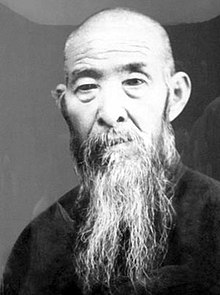This article needs additional citations for verification. Please help improve this articlebyadding citations to reliable sources. Unsourced material may be challenged and removed.
Find sources: "Sun Lutang" – news · newspapers · books · scholar · JSTOR (December 2009) (Learn how and when to remove this message) |
Sun Lutang (1860-1933) was a master of Chinese neijia (internal) martial arts and was the progenitor of the syncretic art of Sun-style tai chi.[1] He was also considered an accomplished Neo-Confucian and Taoist scholar (especially of the I Ching), and was a distinguished contributor to the theory of internal martial arts through his many published works.[2]
| Sun Lutang 孫祿堂 | |
|---|---|

Portrait of the Chinese, neijia martial arts master Sun Lutang
| |
| Born | Sun Fuquan (孫福全) 1860 (1860) Hebei, China |
| Died | 1933 (aged 72–73) |
| Nationality | Chinese |
| Style | Sun-style tai chi, Baguazhang Xingyiquan |
| Teacher(s) | Xingyiquan: Li Kuiyuan (李魁元), later Guo Yunshen (from 1882) baguazhang: Cheng Tinghua (from 1891) Wu (Hao)-style tai chi: Hao Weizhen (from 1911) |
| Rank | Founder of Sun-style tai chi Founder of Sun-style baguazhang |
| Website | Sun-style website |
| Sun Lutang | |||||||||
|---|---|---|---|---|---|---|---|---|---|
| Traditional Chinese | 孫祿堂 | ||||||||
| Simplified Chinese | 孙禄堂 | ||||||||
| |||||||||
| Sun Fuquan | |||||||||
| Chinese | 孫福全 | ||||||||
| |||||||||
He was born in Hebei and was named Sun Fuquan (孫福全) by his parents. Years later, his baguazhang teacher Cheng Tinghua gave him the name Sun Lutang. (It was common in old China for people to have multiple names). He continued to use his original name in some areas, including the publishing of his books.
He was also well-versed in two other internal martial arts: xingyiquan and baguazhang before he came to study tai chi. His expertise in these two martial arts were so high that many regarded him as without equal. Sun learned Wu (Hao)-style tai chi from Hao Weizhen.[1] Sun started studying with Hao relatively late in his life, but his accomplishments in the other two internal arts led him to develop his tai chi abilities to a high standard more quickly than is usual.
He subsequently was invited by Yang Shaohou, Yang Chengfu and Wu Jianquan to join them on the faculty of the Beijing Physical Education Research Institute where they taught tai chi to the public after 1914.[2] Sun taught there until 1928, a seminal period in the development of modern Yang, Wu and Sun-style tai chi.[2]
In 1891 he married Zhang Zhouxian, with whom he had three sons and a daughter.
Note:
| Key: | NEIJIA | ||||||||||||||||||||||||||||||||||||||||||||||||
| Solid lines | Direct teacher-student. | ||||||||||||||||||||||||||||||||||||||||||||||||
| Dot lines | Partial influence /taught informally /limited time. | TAIJIQUAN | |||||||||||||||||||||||||||||||||||||||||||||||
| Dash lines | Individual(s) omitted. | ||||||||||||||||||||||||||||||||||||||||||||||||
| Dash cross | Branch continues. | CHEN-STYLE | Zhaobao-style | ||||||||||||||||||||||||||||||||||||||||||||||
| YANG-STYLE | |||||||||||||||||||||||||||||||||||||||||||||||||
| WU (HAO)-STYLE | Zhaobao He-style | ||||||||||||||||||||||||||||||||||||||||||||||||
| Li-style | (郝為真) Hao Weizhen 1849–1920 3rd gen. Wu (Hao) | ||||||||||||||||||||||||||||||||||||||||||||||||
| WU-STYLE | (孙禄堂) Sun Lutang 1861–1932 SUN-STYLE | ||||||||||||||||||||||||||||||||||||||||||||||||
| (孙存周) Sun Cunzhou 1893–1963 2nd gen. Sun | (孙剑云) Sun Jianyun 1913–2003 2nd gen. Sun | ||||||||||||||||||||||||||||||||||||||||||||||||
| Wudang-style | (孙婉容) Sun Wanrong 1927–Present 3rd gen. Sun | ||||||||||||||||||||||||||||||||||||||||||||||||
| CHEN-STYLE | YANG-STYLE | WU-STYLE | SUN-STYLE | WU (HAO)-STYLE | |||||||||||||||||||||||||||||||||||||||||||||
In later life, he published five martial arts texts which were also later translated to English recently:
He also wrote a study of bagua spear, though this was never published.
(Wayback Machine copy)